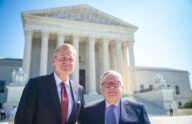PLF petitions "unprecedented and sweeping" Endangered Species Act case to U.S. Supreme Court
In February, 2013, PLF filed suit in federal court on behalf of Markle Interests, LLC., challenging the designation of the landowners’ property as “critical habitat” by the U.S. Fish and Wildlife Service under the Endangered Species Act. “Critical habitat” is defined as habitat areas “essential to the conservation of the species.” But in a bewildering display of creative rule-making, all too common among federal bureaucrats, agency officials set aside more than 1500 acres of private land in St. Tammany Parish, Louisiana, for the protection of the dusky gopher frog even though the land is unsuitable as habitat: It is not near areas inhabited by the species; it is not accessible to the species; it cannot sustain the species without modification; and, it does not support the existence or conservation of the species in any way.
In short, the designated area has no connection to the dusky gopher frog and provides no conservation benefits to the species. Those benefits are provided by the thousands of acres of actual habitat designated as “critical habitat” in the State of Mississippi. Although the government acknowledges the Louisiana parcel provides no current conservation benefits to the gopher frog, the government inexplicably declared the benefits to the species, of designating the land as “critical habitat,” outweighed the harm to the landowners which the government estimated at $34 million in lost value.
A Louisiana District Court judge called the government’s “critical habitat” designation “odd,” “troubling,” “harsh,” and “remarkably intrusive [with] all the hallmarks of governmental insensitivity to private property.” Nevertheless, the judge felt “compelled” to defer to the government on such a technical matter. On appeal in the Fifth Circuit Court of Appeals, two judges on a three-judge panel also deferred to the government. But one judge issued a dissenting opinion recognizing that if the government could regulate nonhabitat as “critical habitat,” the government could regulate any area in the country, without limit. The judge argued this defied both logic and the law.
We sought review of the panel decision by the entire Fifth Circuit court, but the court denied our request on an 8 to 6 vote. In an unusual thirty-two page dissent, the six judges favoring the landowners excoriated the court for allowing the panel decision to stand calling it, rather colorfully, an “execrable” misinterpretation of the statutory text and contrary to Supreme Court precedent. The dissent urged further review warning that the Fifth Circuit decision is “unprecedented and sweeping” because it gives the government “virtually limitless” power to designate “critical habitat” and “the ramifications of this decision for national land use regulation and for judicial review of agency action cannot be underestimated.”
The designation of nonhabitat as “critical habitat” is indeed “unprecedented and sweeping.” The government recently codified this approach in a new rule redefining “critical habitat” which has been challenged by 18 states for exceeding statutory and constitutional authority. Under this rule, the Markle decision, authorizing nonhabitat as “critical habitat,” is now a rule of general applicability establishing a nationwide precedent. This is troubling because it raises a constitutional conflict, in two ways. First, federal regulation of local land and water resources, that have no connection to a protected species, exceeds the commerce power on which the Endangered Species Act is based. And, second, federal regulation of local land and water use unduly impinges on traditional states powers.
To protect landowners across the Country and to defend the Rule-of-Law, today we petitioned the U.S. Supreme Court to review the case and restore a commonsense interpretation of the Endangered Species Act



